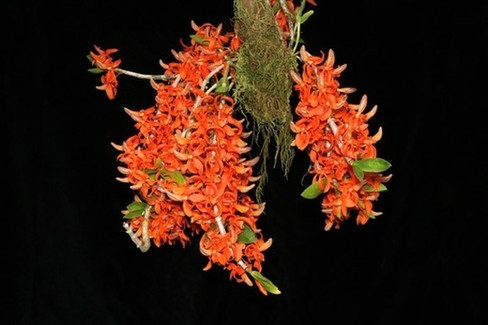All About Orchids
- sbseaweeders

- Oct 16
- 3 min read
We learned so much about the world of orchids from member Cynthia Hill during our September meeting!
Did you know that orchids are among the oldest of all plant families, dating back as many as 125 million years? These beautiful, seemingly fragile plants thrived alongside dinosaurs! They are the largest flowing plant family, with some 28,000 varities. They grow everywhere in the world, except Antarctica, on tree trunks, branches, rocks, in soil and even underground.
Being so old, orchids have had plenty of time to develop into a diverse plant family -- there are orchids of every color, fragrance, size and shape imaginable. And they have developed special pollinator and environmental relationships.
Unlike most flowers, which have radial symmetry, orchids are (with a few exceptions) zygomorphic, which means they have bilateral symmetry. All orchids have three sepals (although in some it looks like two because two lateral sepals are fused) and three petals; however, one of the petals has been modified into a labellum, or lip.
The size, shape and color of an orchid's sepals, petals and lip are determined by the specific pollinator the orchid is trying to attract. Their pollinators can be as small as a fungus gnat or as large as a bat!
One variety -- Darwins Orchid (Angraecum Asparagales) -- has a 17-inch nectary, the

name for the tube carrying nectar to attract pollinators. When this orchid was discovered in Madagascar, no one could imagine which that a pollinator would have such a long proboscis (tongue-like part) that would reach deep within the tube to drink the nectar at the bottom. Darwin, who studied orchids to develop his theory of evolution and natural selection, predicted that there had to be such an insect. Sure enough, it was later discovered that this orchid is pollinated by sphinx moths.
Cynthia started growing orchids some 50 years ago, after moving to San Diego for work in the biotech industry. After moving to the Bay Area in 2005, her collection grew to more than 700 plants that she kept in a greenhouse. Her plants earned Best of Show awards three times at the Pacific Orchid Exposition in San Francisco and at the Huntington Botanical Gardens International Orchid Show in Pasadena. She served as Acting Editor of Orchid Digest magazine and was a judge with the American Orchid Society for many years. She has traveled the world to observe orchids in the wild -- to Madagascar, Borneo, the Philippines, China, Hong Kong, Indonesia, Thailand, Guatemala, Ecuador and Peru. She parted with most of her collection before returning to Solana Beach in 2019 and still grows Cattleya jongheana, Laelia speciosa, Neofinetria falcata, Cochlioda and Dendrobium on her patio.
Orchid Care
Cynthia shared several tips for buying and caring for orchids in our homes or gardens:
Look for healthy, green leaves and light green roots that touch the pot.
Choose plants with a good number of unopened buds, so you can enjoy their blooms longer.
Water with rain water, if possible, or purified or distilled water fortified with a little bit of orchid fertilizer; our "hard" tap water takes a toll on plant health.
Make sure your pots drain well; don't leave orchids in standing water.
Place plants where there is good air movement, but not in drafts or under heat or air conditioning vents.
Repot Phalaenopsis (the variety most commonly found in garden shops) about every two years in orchid bark


















Comments